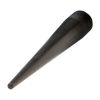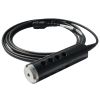YSI 6850 Flow Cell
Features
- Compact design decreases sample volume
- Easily disassembles for quick clean up and disinfection from well to well
- Convenient inserts at the base accommodates the flow cell spike, tripod, or C-clamp
- Free ground shipping
- Expedited repair and warranty service
- Lifetime technical support
- More
Overview
Installation of the YSI 6850 flow cell is easy. Simply thread the flow cell onto the probe module of the Quatro cable assembly. Once secure, water can be pumped to the flow cell with a user-supplied pump. Water enters through the bottom of the flow cell, and passes through a diffuser plate. The water will leave through an opening at the top of the cell. This design ensures that flow is distributed evenly through the cell, eliminating dead zones of no flow along the sides.
- Operating Pressure: 25 PSI max.
- Operating Temperature: -10 to 60 C (14 to 140 F)
- Volume: ~150mL with full sensor suite
- Materials Contacting Sampler: Polyvinyl Chloride (PVC)
- Weight: 612.35 grams (1.35 lbs)
- Diameter (Main Body): 7.32cm (2.88")
- Diameter (Tube): 6.04cm (2.38")
- Height: 14.99cm (5.8")
- (1) YSI 6850 150mL flow cell
- (2) Quick-connect 3/8" tube fittings
- (2) Quick-connect 1/4" tube fittings
- (1) Tube of lubricant
- (2) Replacement O-rings
In The News
Choptank River watershed nitrate monitoring targets conservation efforts
A nutrient monitoring effort throughout a degraded Chesapeake Bay watershed is helping chart the path of nitrate through the system. The monitoring is part of a plan to target federally funded agricultural conservation practices to the places in the watershed that need them most. The Choptank River is among one of the largest tributaries to the Chesapeake Bay, a system plagued by excess nutrients. The Choptank flows across the Delmarva Peninsula, a 170-mile-long piece of land that makes up the bay's eastern shore. More than half of the Choptank's watershed is covered in agricultural land, which is part of the reason the river has been listed as impaired under Clean Water Act standards for nutrients and sediment.
Read MoreRounded pebbles give evidence of past flowing water on Mars
NASA's Curiosity rover has found pebbles that appear to have been rounded by streamflow, according to a release from University of California Davis. Experts say the finding represents the first on-site evidence of sustained flowing water on Mars. The rounded pebbles discovered are only known to form when transported through water over long distances. Their discovery supports theories that the red planet could once have supported life. The smooth rocks were found between the north rim of the planet’s Gale Crater and the base of Mount Sharp, a mountain inside the crater. Researchers say they chose Gale Crater for study because there was a sediment deposit there that typically requires water to form.
Read MoreStudy suggests small dams have more negative effects than large dams
A recent study suggests that small dams may have a greater impact on rivers than large dams, as they divert more water away from rivers, according to a press release from the American Geophysical Union. Researchers from Oregon State University studied China’s Nu River, which is home to a variety of dams in the river main stem and its tributaries. In total, 31 small dams were evaluated and compared to four large dams in the main river stem. The research team compared dam impacts to habitat loss, river channel lengths, land affected and landslide risks among 14 total factors. They found small dams had a greater negative impact in nine out of 14 categories. Small dams, used to divert water to hydropower stations, had some of the most profound impacts on rivers.
Read More


















